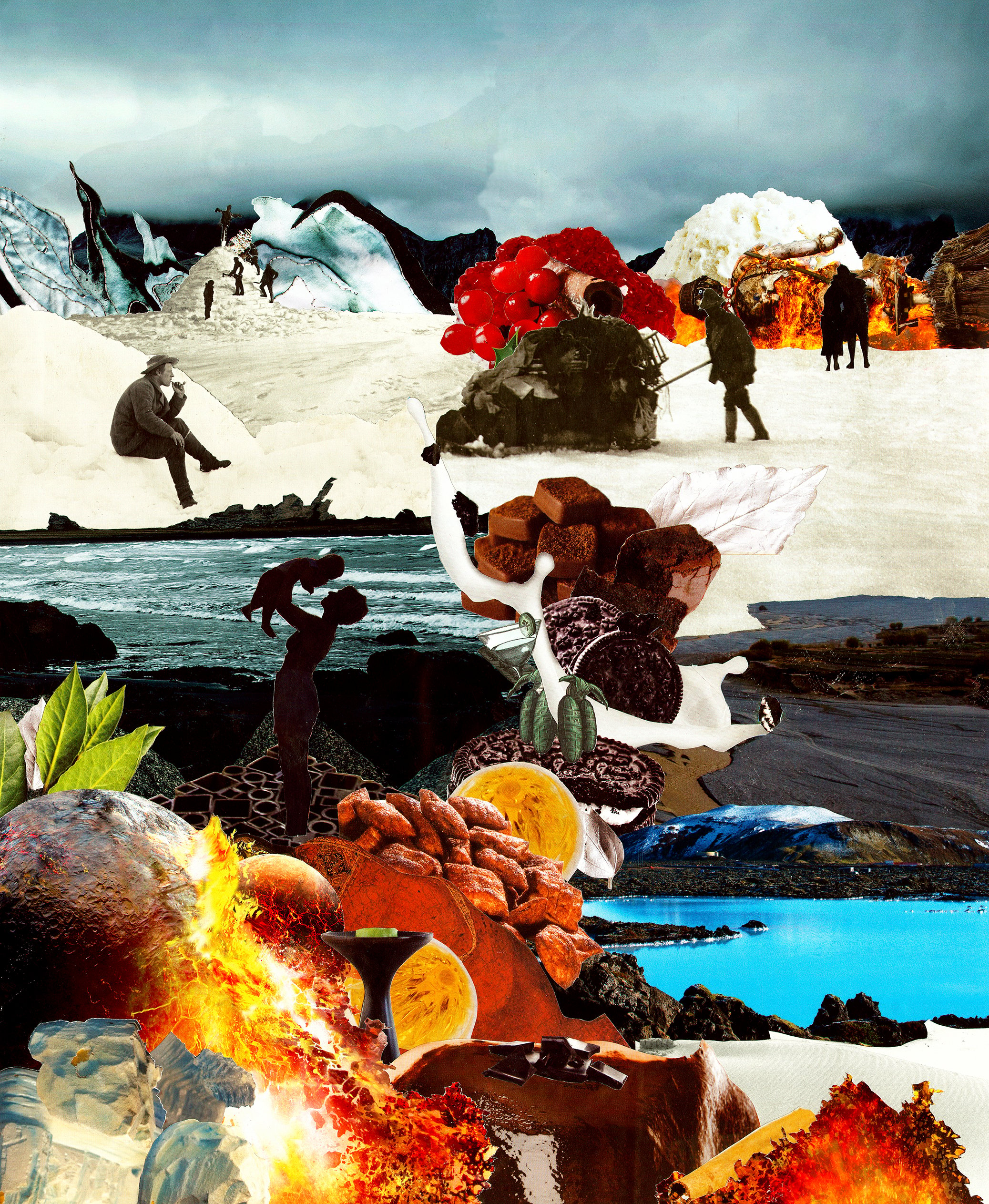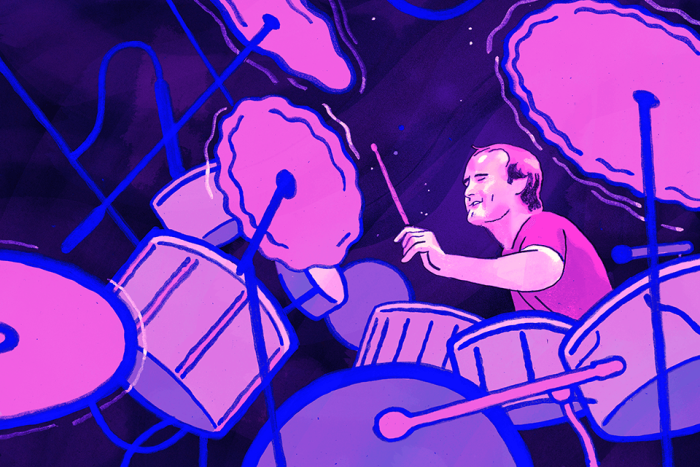
Mouthful is a new monthly column about the author’s relationship with food, ten years into recovery from anorexia and bulimia.
Genevieve was a widow in her seventies. She lived alone in a two-bedroom apartment bordering a creek. In one photograph from my infanthood, I’m curled up on a patio chair beside her with my foot in my hand and a stuffed rabbit in my mouth—she’d been babysitting me since shortly after I was born. When I was old enough to walk, we would stroll around her neighborhood visiting our favorite landmarks: the elephant ear plant outside her front door; the pink elephant statue at the entrance of her apartment complex; the lions outside of the Chinese restaurant up the block.
At night, I would fall asleep on a sleeping bag spread open on the floor beside her while she watched MacGyver. Her dead husband’s portrait hung next to the TV. Behind us sat the locked candy cabinet, the sweets inside being the kind commonly associated with elderly women: butterscotch, dinner mints, caramels, black licorice. There were whole, shiny bags of it, constantly replenished—I was allowed two pieces each time, and would make my selections based upon what I had chosen during my last visit, focusing on variety. Still, some candies won out over others. I had a taste for dinner mints and flavored caramels. The black licorice was my favorite.
Licorice was also what Genevieve guarded most closely. She had bladder cancer and would die when I was eight; she ate licorice to treat her inflammation. Even though I didn’t know at the time that she was sick, when she explained this to me it made sense: The medicinal taste of the licorice, brown and herbal, was unlike the simple sweetness of other candies. Its flavor was mysterious, bordering on mythical, conjuring images of old timey doctors selling tinctures out of wagons. Somehow this related to the numbness it left in my mouth. Licorice wrapped around other flavors, turning them purple and syrupy.
*
Like most kids, I loved candy without prejudice. But as I got older, I especially loved the ones whose tactile experience was on par with their sweetness—in texture, but especially in residual effect: I wanted the burn of Fireballs, the tingle of Pop Rocks, the pucker of Warheads, the numb of licorice.
Soon I realized that children like me were different from those who preferred uncomplicated candies. Too edgy for Skittles, we were cursed by our attraction to altered states of feeling, especially pleasure mingled with pain—considered every jolt of it a battle wound, proof of our vast scope of experience, our ability to withstand. If we ate gummies, they had to be sour gummies. If I was eating sour gummies, I had to eat the whole bag, had to eat them until a layer of burnt taste buds lay across my tongue, dulling every other sensation. I’d slide my tongue across the smooth surfaces of my mouth, feeling again and again the sweet ache of my self-inflicted injury.
*
As a kid, I spent a lot of time at the movie theater—first to see movies, then just to hang around once some friends got jobs there. I’d sneak into the theaters. I’d take pictures in the photo booth and do my makeup in the girls’ bathroom. My on-and-off boyfriend worked there for a while. My best friend was a shift supervisor. It was a good day when I’d catch her behind the snack counter—she’d sneak me candy and we’d sit out on the steps after the last showing and smoke cigarettes and get high on sugar.
Milk Duds are fine; I have nothing against them. They aren’t my favorite candy but they’re also not Smarties, which I find as unpleasant as shaving my legs dry. They were a safe choice to make in a moment of uncertainty.
My favorite movie theater candy has always been Good & Plenty. I love the simple elegance of the white against the pink, and the streaks they leave on my hand on a hot day. The crunch of the candy coating and the give of the soft licorice centers hit all of my pleasure zones; I can still eat a whole box in a single sitting. I bought one this morning at the supermarket in anticipation of writing this paragraph and finished it before sitting down to do so.
But at some point during my adolescence, I stopped asking for Good & Plenty at the snack counter. None of my movie theater friends ate them and some had even told me they thought they were gross. Among the people who thought this were one or two boys I found pretty cute and would have liked to impress, and even seemed to be impressing now and then, though I couldn’t be sure. Like a self-conscious teenager, I switched to Milk Duds, hoping that doing so would help attract the attention I desired.
Milk Duds are fine; I have nothing against them. They aren’t my favorite candy but they’re also not Smarties, which I find as unpleasant as shaving my legs dry. They were a safe choice to make in a moment of uncertainty.
Looking back on this now, though, I feel sad for my younger self, who was fragile in her uniqueness, and in the implicitly torturous position of asking for love. Seeing herself as she imagined others saw her, she judged herself as too strange. She rushed to change herself into a person who liked more popular, easier-to-understand candies instead of trusting that she could find someone who liked her for her unusual and mysterious tastes. Even if she found those simpler candies slightly boring, she found the possibility of rejection unbearable.
*
I’ve loved often and loved hard. My love knows nothing of logic but it has a pattern and clings to other patterns—I observe myself as a creature in love, and so notice these happenings in my psychic world. I can demonstrate my love with imagery but I can’t explain it. It burns brightly, deeply, longs for, hungers after. Each love object has a corresponding set of images and a soundtrack—I don’t do this consciously; my psyche does it for me. In the world of my psyche, each love is assigned the persona of a king. My husband’s name is David, so he is King David of the bible. One love was a lion, because of his long hair. Another was Midas, another the Sun. In the throes of infatuation, the imagery of my love will seem to appear in the world around me. I will see it, smell it, taste it. I will lock it away in my memory as evidence of the cosmic destiny of this new love. I’ve wanted love this badly, this powerfully.
I’ve wanted the disorientation, the tingle, the mingling of thrill and dread, the rush. At times, I’ve wanted to see how long I could keep the metaphorical Fireball in my mouth; I kept it in there just to prove to myself that I could, even if it hurt, even after it lost its flavor. I did this willingly, and that was half the rush of it: that something was hurting me that no one else could see, and that in a way the hurt was a private victory. It can be fun to have a secret, even if that secret is killing you—especially if that secret feels like the only thing you have that is yours alone.
When I was a kid, though, I could never actually keep a Fireball in my mouth—as much as I loved it, I would have to take it out and hold it in my hand, drying and sticky, putting it back in after the heat subsided. And even then, my tongue would be sensitive. The original hurt was still there. Over years of eating spicy foods, I’ve since developed a high pain threshold. I can take a lot of heat—I’d put hot sauce on just about anything—but even now, the burn of a Fireball is sometimes too much for me. I bite and chew them to disburse the heat. For hours afterward, my mouth feels tender. Still, I appreciate their sweetness.
*
Recently, love left a cinnamon burn in my mouth. I’d gone back to my hometown for a few weeks; he was someone I knew from the years I lived there as a young adult. Seven years after meeting, we sat at a bar and drank beers and ate waffle fries, shutting the place down. The next morning, we served breakfast to homeless citizens at a local church. We brought a picnic to kayak on Tampa Bay, but opened only the champagne and orange juice, which we drank out of jars. We drove to Tampa to see a friend’s band play, and on the way stopped at a gas station. “Do you want anything?” he asked me while paying for his gas. Yes, I said. Big Red.
I chewed Big Red in his passenger seat on the way to the show. I chewed it on the way home, holding his hand.
Back in New York, I wrote a letter and slipped a piece of Big Red inside it, holding the envelope under my nose before licking the glue. Over the next several weeks, the taste of Big Red became a symbol for the space between us: sweet and hot, thrilling then painful.
That letter received a response, but soon after the responses stopped. Over time, I stopped buying Big Red in bodegas, stopped seeking it out in the checkout line, stopped wanting very much to taste it.
This week, in anticipation of seeing him again soon, I’ve carried a pack of Big Red around in my purse, replacing it when I’ve chewed all five sticks. I replace them often because I chew them quickly. I want to maintain the intensity of their burn even though, like long-distance love, I know it’s impossible.
*
I’m not a big drinker, but I love whiskey. All kinds, but in descending order: bourbon, moonshine, Scotch, and rye. Drinking whiskey is bittersweet. Like a cowboy, even in a moment of repose, the weight of the world is upon me with a glass of whiskey in my hand. I drink it neat. I love the burn across my gums and behind my nose, the way it clears my palate for a rush of smoky sweetness, how it leaves my lips tingling. I light a cigarette and reflect on whatever brought me to the whiskey this time; the soft touch of the cigarette smoke offsets the liquor’s bite. Part of the bittersweetness of this moment is its solitude, both innate to the drinker and a result of the whiskey itself: with each sip, the world recedes further into warmth, numbness; sadness becomes tolerable; I’m comfortable alone.
I say that I love moonshine, but really there’s only one distillery I love—I won’t name it, but I will tell you how I discovered it. I was in Asheville three years ago. I thought I’d destroyed my marriage. I’d fucked up royally, had harbored romantic feelings for another person and had lied about them—I mean really lied about them; the lie was the problem, not the feelings—and had boarded a bus to North Carolina to escape the conflict, as is my pattern.
That night, I crashed at the apartment of a girlfriend from back home. In the morning, we drove to the distillery, which she had told me about, and joined up with a tour. I had never tried moonshine. All I knew about it was what I’d gleaned from westerns. I expected something on par with bathtub gin, likely to render me catatonic after even a small dose, and tasting like floor polish. At this point, I hadn’t yet discovered my love of whiskeys. I had an inkling that I liked bourbon, but wasn’t yet looking to branch out from it.
We followed the son of the distillery’s owner around shiny silver vats and pressure gauges. We listened to him talk about the sweetness of corn and the importance of clean water, his family’s distillation process, and the pride they derived from having invented a method of delivering whiskey’s sweetness without its bite. Bite is a result of impurities, he said, of cheapness and laziness—moonshine only bites when its maker is cheating.
Their moonshine tasted faintly of bananas. They served it to us in tiny plastic cups. I asked for seconds and then thirds. I bought a bottle and gave it to my husband the next day when he arrived from New York. He’d driven to Asheville to save us.
*
Back in New York, we went to our favorite restaurant. This place has been the site of some of the happiest and most brutal moments of our marriage: our anniversaries and our most toxic fights. It’s decorated in the style of a French Quarter saloon. The bar is a marble U-shape; the bartenders wear cuffs and suspenders; they’re always playing jazz.
In our custom, we ordered oysters and absinthe. We knew that the absinthe would numb our mouths, making it harder to taste the peculiarities of each oyster—we’d discussed this before and had even experimented with ordering other drinks, as this restaurant is famous for its cocktails. We enjoyed the cocktails, but always returned to the absinthe. The familiarity of it is rare—and a certain rareness remains within it, even though it’s familiar.
Collage by Sarah Gerard.





